NASA åbner månestensprøver forseglet siden Apollo-missioner (opdatering)
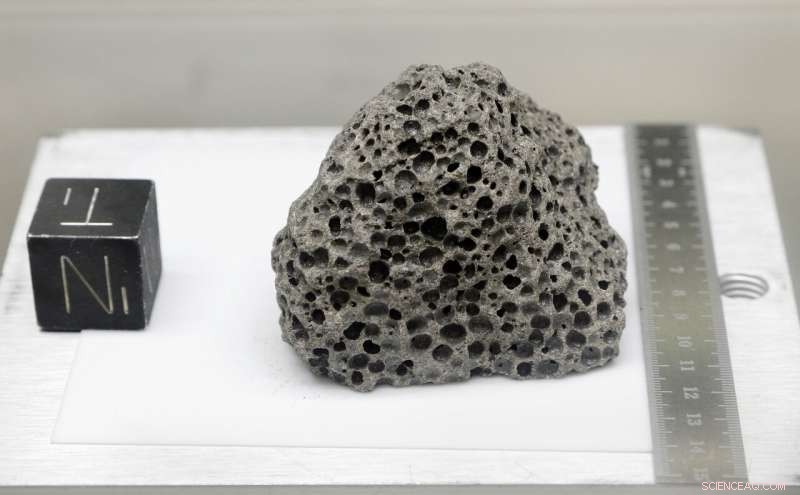
Samlet under Apollo 15, en 3,5 milliarder år gammel basaltsten, der ligner klipper dannet omkring Hawaii, er vist i en tryksat nitrogenfyldt undersøgelseskasse inde i månelaboratoriet på NASA Johnson Space Center mandag, 17. juni, 2019, i Houston. For første gang i årtier, NASA er ved at åbne nogle af de uberørte prøver og lade geologer tage fat på dem med teknologi fra det 21. århundrede. (AP Photo/Michael Wyke)
Inde i en aflåst hvælving i Johnson Space Center er en skat, som få har set og færre har rørt ved.
Det begrænsede laboratorium er hjemsted for hundredvis af pund månesten indsamlet af Apollo-astronauter for næsten et halvt århundrede siden. Og for første gang i årtier, NASA er ved at åbne nogle af de uberørte prøver og lade geologer tage fat på dem med teknologi fra det 21. århundrede.
Hvilken bedre måde at markere sommerens 50-års jubilæum for menneskehedens første fodspor på månen end ved at dele lidt af månens bytte.
"Det er en slags tilfældighed, at vi åbner dem i årsdagen, " forklarede NASAs Apollo-prøvekurator Ryan Zeigler, dækket top til tå i hvid beskyttelsesdragt med matchende stofstøvler, handsker og hue.
"Men jubilæet øgede bestemt bevidstheden og det faktum, at vi skal tilbage til månen."
Med det gyldne jubilæum for Neil Armstrong og Buzz Aldrins bedrift nærmer sig hastigt - landede deres månemodul Eagle den 20. juli, 1969, på Stillhedens Hav - månen er rødglødende igen.
Efter årtiers flip-flot mellem månen og Mars som den næste store astronautdestination, NASA sigter mod at sætte astronauter på månens overflade igen i 2024 efter Det Hvide Hus' anvisning. Præsident Donald Trump foretrækker at tale Mars op. Men der er konsensus om, at månen er en afgørende prøveplads i betragtning af dens relative nærhed til hjemmet - 240, 000 miles (386, 000 kilometer) eller to til tre dage væk.
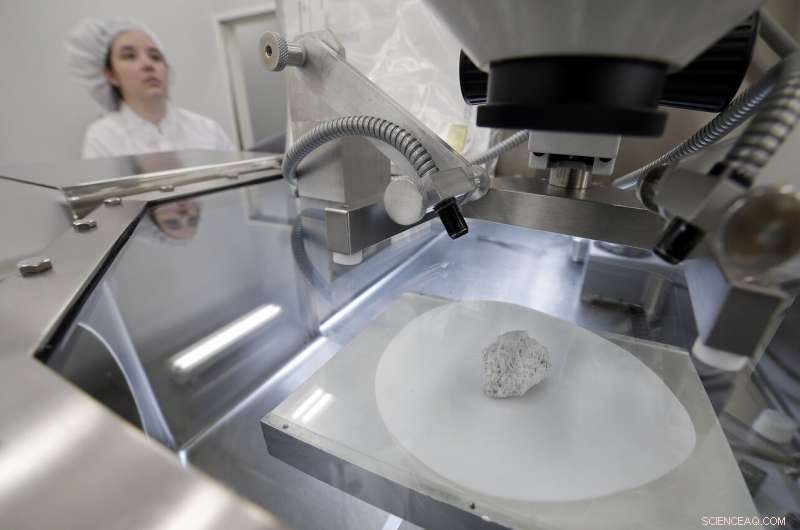
Genesis Rock, forgrunden, en 4,4 milliarder år gammel anortositsten, cirka 2 tommer i længden, bragt tilbage af Apollo 15 og brugt til at bestemme månen blev dannet af et gigantisk nedslag, sidder under glas inde i en tryksat nitrogenfyldt undersøgelseskasse som Lacey Costello, en Apollo prøvekurationsprocessor, arbejder med andre prøver på ydersiden af kabinettet inde i månelaboratoriet på NASA Johnson Space Center mandag, 17. juni, 2019, i Houston. (AP Photo/Michael Wyke)
Zeiglers opgave er at bevare, hvad de 12 moonwalkers bragte tilbage fra 1969 til 1972 - måneprøver på i alt 842 pund (382 kg) - og sikre, at videnskabsmænd får de bedst mulige prøver til undersøgelse.
Nogle af jorden og klippestykkerne blev vakuumpakket på månen - og blev aldrig udsat for Jordens atmosfære - eller frosset eller opbevaret i gasformigt helium efter sprøjt og derefter efterladt urørt. Laboratoriets personale forsøger nu at finde ud af, hvordan man bedst kan fjerne prøverne fra deres rør og andre beholdere uden at forurene eller ødelægge noget. De øver sig med mock-up udstyr og lader som om månesnavs.
Sammenlignet med Apollo-æraens teknologi, nutidens videnskabelige instrumenter er meget mere følsomme, Zeigler bemærkede.
"Vi kan gøre mere med et milligram, end vi kunne gøre med et gram dengang. Så det var rigtig god planlægning fra deres side at vente, " han sagde.
Måneprøvelaboratoriet har to side-by-side hvælvinger:en til sten, der stadig er i lige-fra-månen-tilstand og en mindre hvælving til prøver, der tidligere er udlånt til undersøgelse. Omkring 70 procent af det oprindelige træk er i den uberørte prøvehvælving, som har to kombinationer og kræver to personer at låse op. Omkring 15 procent er i opbevaring hos White Sands i New Mexico. Resten bruges til forskning eller fremvisning.
-
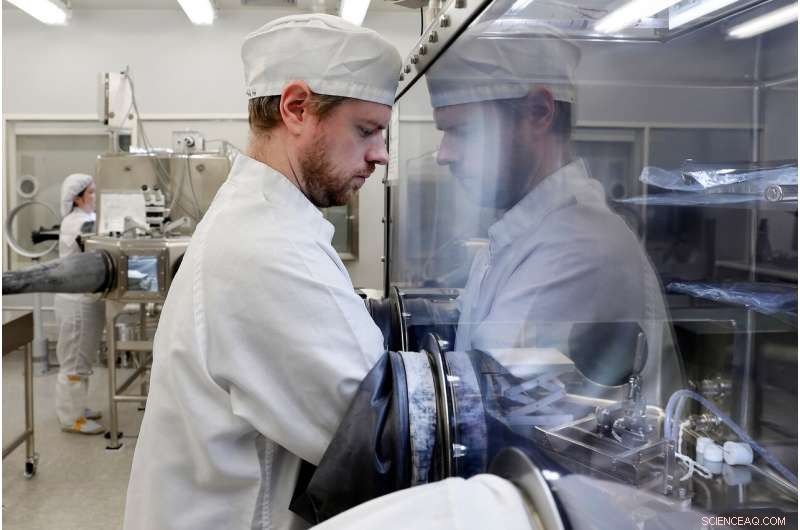
Jeremy Kent, Apollo-kurator, arbejder med måneprøver i en forseglet, nitrogentryksundersøgelsesboks inde i månelaboratoriet på NASA Johnson Space Center mandag, 17. juni, 2019, i Houston. Prøverne holdes altid inde i et nitrogenmiljø for at forhindre henfald og nedbrydning, selvom de flyttes mellem laboratoriet og opbevaringsboksen. (AP Photo/Michael Wyke)
-
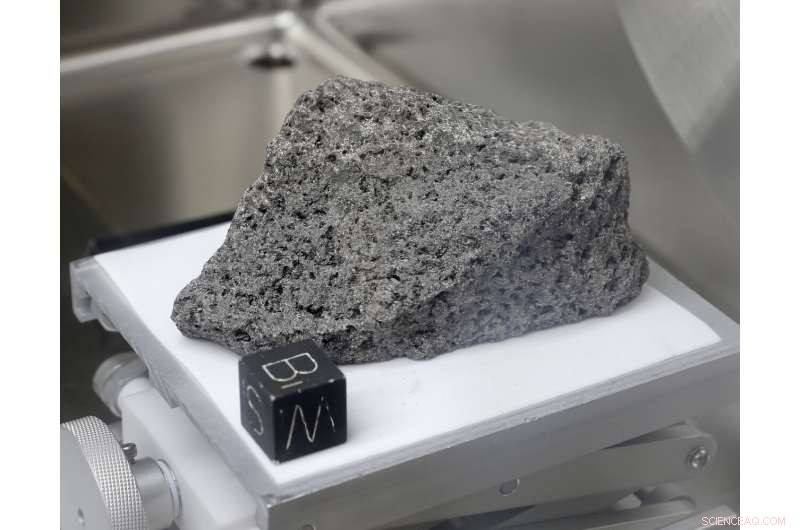
Samlet under Apollo 17, en 3,5 milliarder år gammel basaltsten kendt som "The Children of the World" eller "The Goodwill Sample" vises i månelaboratoriet på NASA Johnson Space Center mandag, 17. juni, 2019, i Houston. Det blev brugt til at lave prøver, der blev givet til alle lande på jorden. (AP Photo/Michael Wyke)
-

Collected during Apollo 16, an anorthosite sample believed to be the oldest rock collected during the moon missions is displayed in the lunar lab at the NASA Johnson Space Center Monday, June 17, 2019, in Houston. Scientists also believe it to be from the original crust of the moon just after it cooled. (AP Photo/Michael Wyke)
-
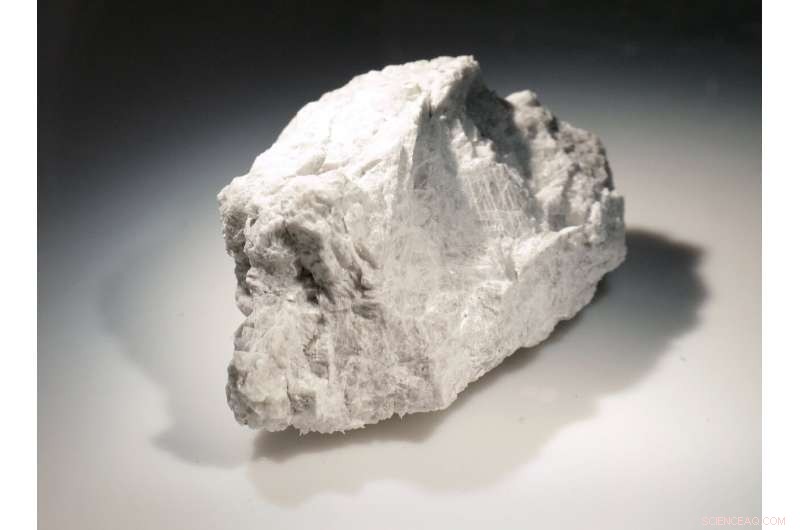
The "Genesis Rock, " a 4.4 billion-year-old anorthosite sample approximately 2 inches in length, brought back by Apollo 15 and used to determine the moon was formed by a giant impact, is lit inside a pressurized nitrogen-filled examination case in the lunar lab at the NASA Johnson Space Center Monday, June 17, 2019, in Houston. (AP Photo/Michael Wyke)
-
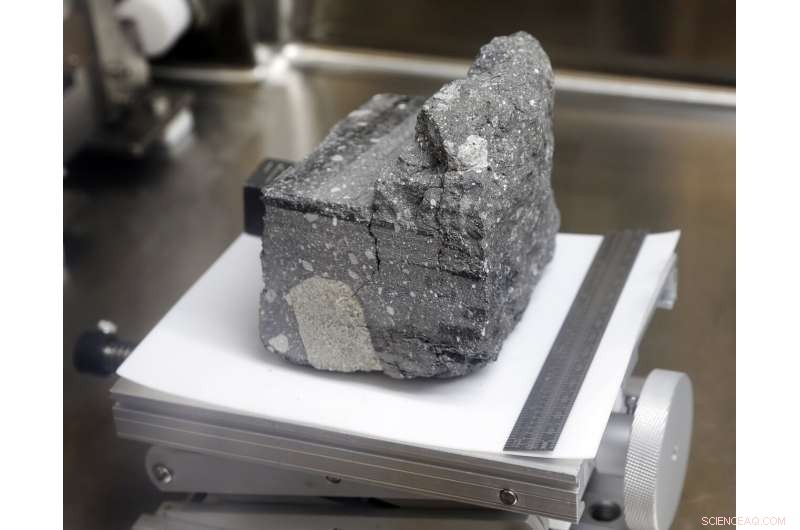
A regolith breccia rock of sintered lunar soil, dating 3.2 billion years old and collected by Apollo 15, is displayed in a pressurized nitrogen-filled case inside the lunar lab at the NASA Johnson Space Center Monday, June 17, 2019, in Houston. (AP Photo/Michael Wyke)
-
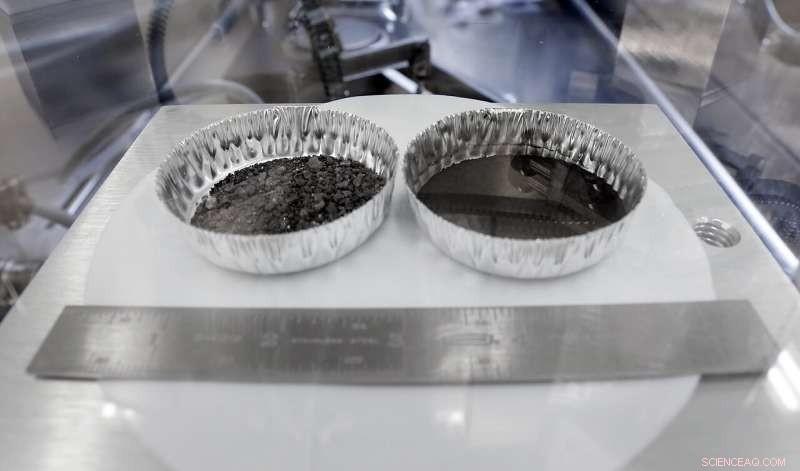
Two separate 2 inch foil pans hold lunar dirt, from the last shovel full collected by Neil Armstrong on the Apollo 11, in the lunar lab at the NASA Johnson Space Center Monday, June 17, 2019, in Houston. (AP Photo/Michael Wyke)
-

Ryan Zeigler, Apollo sample curator, venstre, stands next to a nitrogen-filled case displaying various lunar samples collected during Apollo missions 15, 16 and 17, inside the lunar lab at the NASA Johnson Space Center Monday, June 17, 2019, in Houston. (AP Photo/Michael Wyke)
-
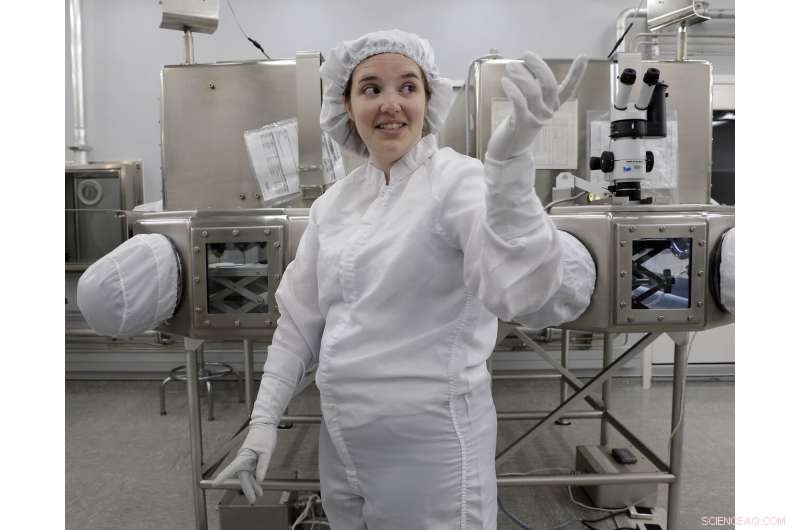
Lacey Costello, Apollo sample curation processor, talks about her job examining lunar samples inside the lunar lab at the NASA Johnson Space Center Monday, June 17, 2019, in Houston. (AP Photo/Michael Wyke)
-
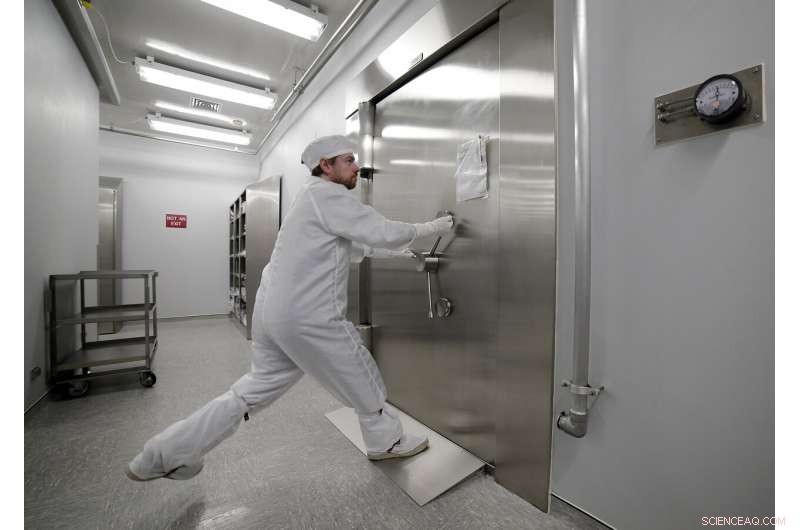
Jeremy Kent, Apollo sample curation processor, tugs to open the 1978 U.S. federal bank vault that protects the entrance to the lunar sample vault inside the lunar lab at the NASA Johnson Space Center Monday, June 17, 2019, in Houston. The door requires two separate combinations, held by two separate people, to open. (AP Photo/Michael Wyke)
Of the six manned moon landings, Apollo 11 yielded the fewest lunar samples:48 pounds or 22 kilograms. It was the first landing by astronauts and NASA wanted to minimize their on-the-moon time and risk. What's left from this mission—about three-quarters after scientific study, public displays and goodwill gifts to all countries and U.S. states in 1969—is kept mostly here at room temperature.
Armstrong was the primary rock collector and photographer. Aldrin gathered two core samples just beneath the surface during the 2 1/2-hour moonwalk. All five subsequent Apollo moon landings had longer stays. The last three—Apollo 15, 16 and 17—had rovers that significantly upped the sample collection and coverage area.
"Fifty years later, we're still learning new things ... incredible, " said the lab's Charis Krysher, holding a clear acrylic marble embedded with chips of Apollo 11 moon rock in her gloved hand.
By studying the Apollo moon rocks, Zeigler said, scientists have determined the ages of the surfaces of Mars and Mercury, and established that Jupiter and the solar system's other big outer planets likely formed closer to the sun and later migrated outward.
"So sample return from outer space is really powerful about learning about the whole solar system, " han sagde.
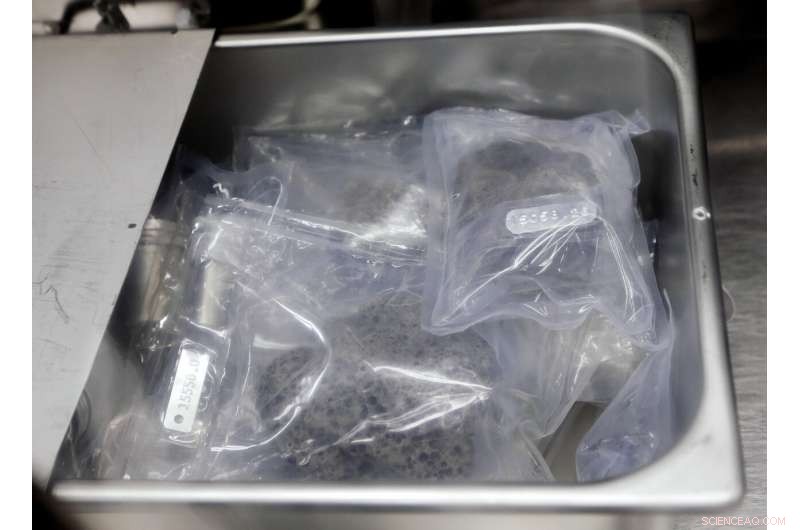
A stainless steel bin is opened to show individually tagged and sealed lunar samples collected during Apollo 16 inside a pressurized nitrogen-filled case holding the samples from that mission in the lunar lab of the NASA Johnson Space Center Monday, June 17, 2019, in Houston. (AP Photo/Michael Wyke)
Andrea Mosie, who's worked with the Apollo moon rocks for 44 years and was a high school intern at Johnson Space Center in July 1969, remembers the Polaroid photos and handwritten notes once accompanying each sample. She sometimes gets emotional when talking to children about the moonshots and does her best to dispel any notion that the rocks aren't from the moon and the lunar landings never happened.
"The samples are right here and they're still in a pristine state, " she assures young skeptics.
Most of the samples to be doled out over the next year were collected in 1972 during Apollo 17, the final moonshot and the only one to include a geologist, Harrison Schmitt. He occasionally visits the lunar sample lab and plans to help open the fresh specimens.
The nine U.S. research teams selected by NASA will receive varying amounts.
"Everything from the weight of a paperclip, down to basically so little mass you can barely measure it, " Zeigler said.
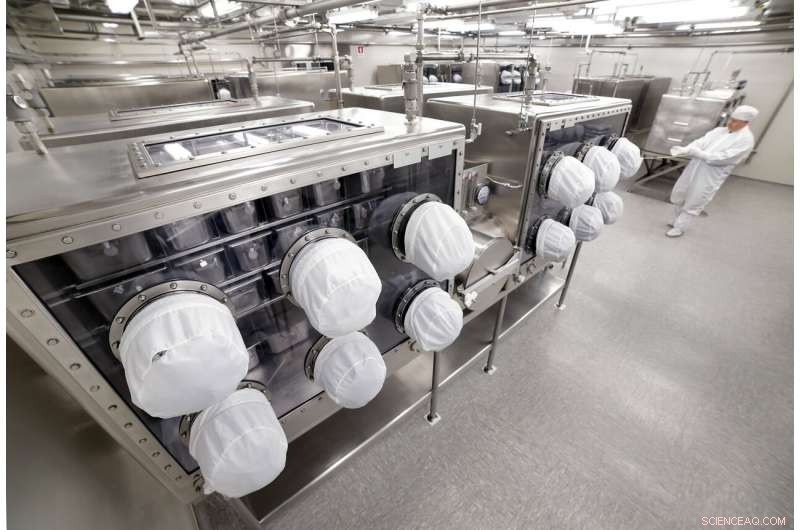
Pressurized nitrogen-filled cases hold lunar samples collected from Apollo 11, venstre, and Apollo 12, ret, with NASA's Apollo sample curator Ryan Zeigler in the background, inside the lunar sample vault in the lunar lab at the NASA Johnson Space Center Monday, June 17, 2019, in Houston. The restricted lab is home to hundreds of pounds of moon rocks collected by Apollo astronauts close to a half-century ago. (AP Photo/Michael Wyke)
Especially tricky will be extracting the gases that were trapped in the vacuum-sealed sample tubes. The lab hasn't opened one since the 1970s.
"If you goof that part up, the gas is gone. You only get one shot, " Zeigler said.
The lab's collection is divided by mission, with each lunar landing getting its own cabinet with built-in gloves and stacks of stainless steel bins filled with pieces of the moon. Apollo 16 and 17, responsible for half the lunar haul, get two cabinets apiece.
The total Apollo inventory now exceeds 100, 000 samples; some of the original 2, 200 were broken into smaller pieces for study.
Sample processor Jeremy Kent is hopeful that "we will get some more samples here in the lab to work on."
There's space for plenty more.
© 2019 The Associated Press. Alle rettigheder forbeholdes.
 Varme artikler
Varme artikler
-
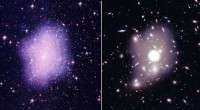 Mørkt stof rammer måske den rigtige tone i små galakserAstronomer observerede, at det mørke stof ikke ser ud til at klumpe sig særlig meget i små galakser, men deres tæthed topper skarpt i større systemer som galaksehobe. Det har været et puslespil, hvorf
Mørkt stof rammer måske den rigtige tone i små galakserAstronomer observerede, at det mørke stof ikke ser ud til at klumpe sig særlig meget i små galakser, men deres tæthed topper skarpt i større systemer som galaksehobe. Det har været et puslespil, hvorf -
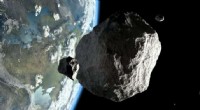 Hvorfor farlige asteroider på vej til Jorden er så svære at opdageHvor tæt kan en potentielt farlig asteroide komme, før den bliver opdaget? Kredit:Shutterstock/Alexyz3d Jorden er ofte i skudlinjen af fragmenter af asteroider og kometer, hvoraf de fleste brænd
Hvorfor farlige asteroider på vej til Jorden er så svære at opdageHvor tæt kan en potentielt farlig asteroide komme, før den bliver opdaget? Kredit:Shutterstock/Alexyz3d Jorden er ofte i skudlinjen af fragmenter af asteroider og kometer, hvoraf de fleste brænd -
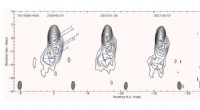 Observationer afslører egenskaberne af neutrino-emitterende blazarerParsec-skala radiostruktur af TXS 0506+056 ved 15 GHz. Kredit:Li et al., 2020. Ved at bruge Very Long Baseline Interferometry (VLBI) teknikken, astronomer har undersøgt strålen i parsec-skala fra
Observationer afslører egenskaberne af neutrino-emitterende blazarerParsec-skala radiostruktur af TXS 0506+056 ved 15 GHz. Kredit:Li et al., 2020. Ved at bruge Very Long Baseline Interferometry (VLBI) teknikken, astronomer har undersøgt strålen i parsec-skala fra -
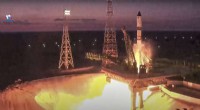 Russisk fragtskib løfter til den internationale rumstationPå dette billede taget fra video leveret af Roscosmos Space Agency Press Service, en Soyuz-raket med Progress MS-17-lasten eksploderer fra affyringsrampen ved Ruslands rumfacilitet i Baikonur, Kasakhs
Russisk fragtskib løfter til den internationale rumstationPå dette billede taget fra video leveret af Roscosmos Space Agency Press Service, en Soyuz-raket med Progress MS-17-lasten eksploderer fra affyringsrampen ved Ruslands rumfacilitet i Baikonur, Kasakhs
- Forskere udvikler revolutionerende nanoteknologi kobberlodde
- Teleskoper i rummet for endnu skarpere billeder af sorte huller
- Slange-inspireret robot bruger kirigami til at bevæge sig
- Egenskaber for Igneous Rocks for Kids
- Hvordan hajer og andre dyr udviklede elektroreception for at finde deres bytte
- COVID-åndedrætstest-kan det være det næste? Forskning siger ja


